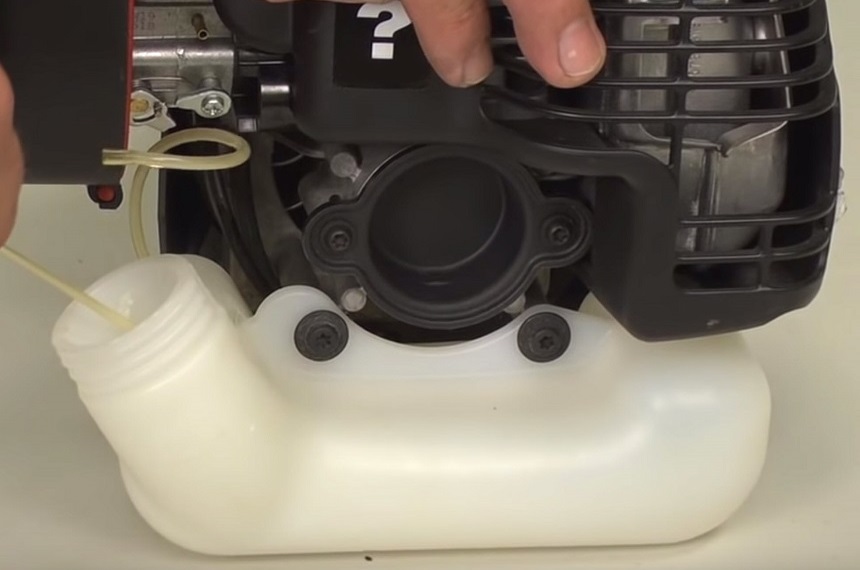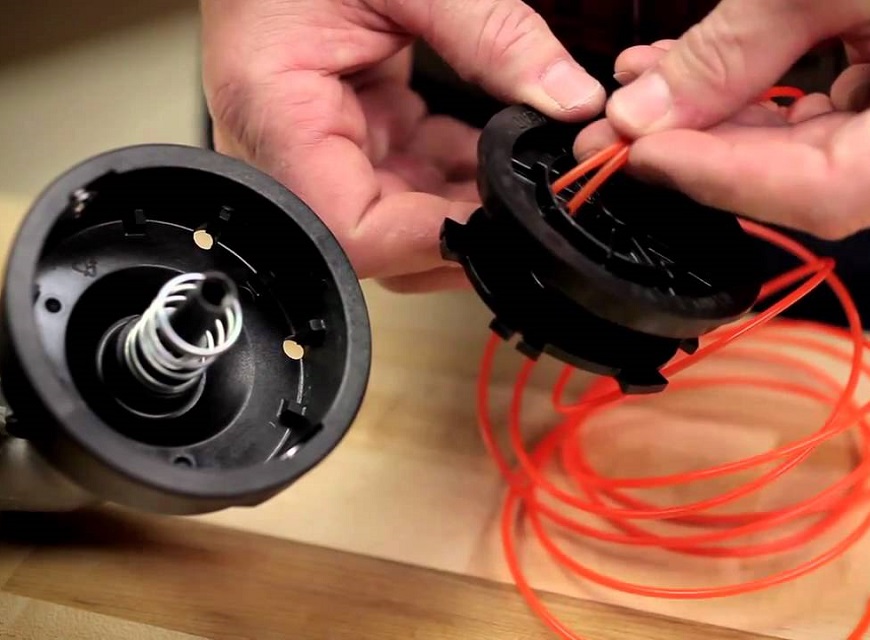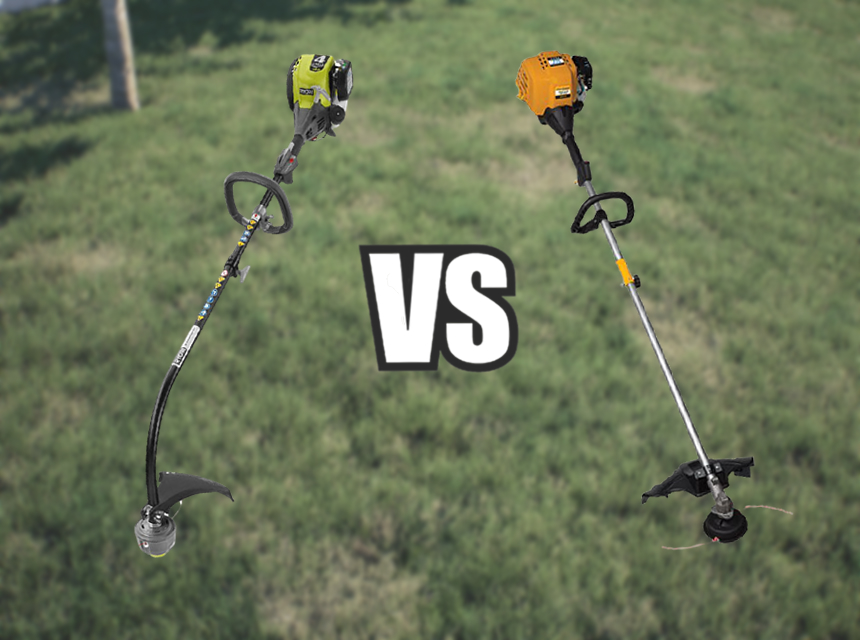
Unless you’re a proper gearhead, it’s not often that things like engine cycles and induction systems catch your attention. However, if you’re considering buying a gas-powered string trimmer, you need to get in on the debate about 2-cycle vs 4-cycle trimmers.
There are many reasons why you need to worry about 2-cycle and 4-cycle engines, but the most important ones are price, maintenance, emissions, and noise. These factors also apply to other gas-powered small engines used in lawn edgers, powersaws, tillers, and even jet skis.
The terms 2-cycle and 4-cycle engines refers to the number of strokes the piston makes to give one power stroke. Thus, a 2-cycle engine has a power stroke every two cycles of the piston or every one revolution, while a 4-cycle has a power stroke every four cycles or every two revolutions of the crankshaft.
Yes, it’s all very fascinating and geeky, but remember that you don’t have to endure a gas-powered lawn mower if you don’t want to. Some of the best electric lawn mowers and the best electric weed eaters today are really good as well, besides being much quieter. If you still want to get into the greasy details and learn the difference between 2-cycle and 4-cycle weed whackers, read on.
George Ballas invented the Weed Eater Trusted Source George Ballas, Inventor of the Weed Whacker, Dies at 85 - The New York Times George C. Ballas loved tending to his lawn with meticulous care, but the 200 or more trees crowding a two-acre expanse behind his house in Houston posed a problem: how to get around the bulging roots and manicure close enough to achieve the near perfection he desired. www.nytimes.com because he wanted a piece of equipment that would give greater precision and delicacy in lawn care. Unlike the traditional edger which is highly aggressive, a good string trimmer offers a soft touch and is much more maneuverable in hard hard-to-reach places such as corners, along the fence, and around trees.
George named his invention the Weed Eater, which is a trademarked name, and the string trimmer has since become common in almost every American household. We also know these amazing lawn care tools as weed whackers, string trimmers, strimmers, line trimmers, weed cutters, whipper snippers, and many other endearing names.
And what’s not to love about a string trimmer? It’s the perfect tool to give your lawn a manicured look with neat edging. It also works great in gardens and near fences to reach into those corners when you need to trim grass and cut weeds. It’s a multipurpose tool that every serious gardener should have.
Two-cycle string trimmers were originally used almost exclusively in string trimmers and other small engines. They were simply easier to make and more practical to own.
Two-stroke engines have a power stroke every one revolution of the crank, which is every two strokes of the piston. They manage this feat by combining the combustion stroke and the compression stroke in one cycle, and the intake and exhaust strokes in the other cycle.
The magic of s two-stroke engine lies in its design. The main difference in a two-stroke engine compared to a four-stroke is that it uses the crank case as part of the induction system (crankcase compression).
It also has a transfer port to link the crankcase and upper part of the cylinder. Watch this animated video to understand more about these components:
First Stroke (Power Stroke) – Compression and Ignition
The first stroke starts with the piston halfway in the cylinder and moving upwards. In this position, the piston head closes both the intake port and the exhaust ports and compresses the air-fuel mixture above it.
At the same time, the volume in the crankcase below the piston head is increasing, thus creating a partial vacuum. This causes air/fuel mixture to fill the crankcase, although it won’t reach the ignition chamber until the top of the transfer port is opened on the downward stroke.
At the top of the compression stroke, the spark plug ignites and forces the piston to start its downward motion. As it moves down, it opens both the exhaust port and intake (transfer) ports. The hot exhaust gases go out and are helped along the way by the incoming air/fuel mixture, which is cooler and denser.
To force air into the combustion chamber, a valve closes off the inlet from the carburetor to begin the compression stroke as the piston starts to move upwards. The cycle repeats itself once the piston is halfway up.
The design of a two-stroke engine means that it needs to use premix petroil, which is a mixture of gasoline and oil. This is necessary because the crankshaft is part of the induction system and can’t be flooded with oil.
This simple design in a 2-stroke engine yields many benefits and some disadvantages as well.
Pros
Cons
Build quality is important in a 2-stroke string trimmer to help offset these inherent disadvantages. One popular model is the SRM-225 21.2cc string trimmer. This is a heavy-duty machine with an anti-vibration system and a long 59-inch straight shaft, yet it only weighs 20lbs.
Four-stroke engines have become more common in weed eaters, and are almost always used in bigger machines from motorcycles to trucks. The main design difference is the fact that four-strokes come with a sealed cylinder except for the valves at the top. The crankcase is also separated from the combustion chamber, so it is usually flooded with oil for lubrication.
A critical component of four-stroke engines is the presence of a valve head. This is the cover to the combustion chamber that houses the intake valve, valve timing mechanism, exhaust valve, fuel injection, spark plug, and the air intake.
It’s easier to understand the operation of a four-stroke engine because they are more practical. If you are interested, you can start with this video animation to understand the basic design of a four-stroke engine:
This first stroke happens as the piston is moving downwards and the intake valve is open. The piston creates a partial vacuum in the combustion chamber, thus drawing in the fuel/air mixture. At the end of the intake stroke, the intake valve closes.
When the piston starts to travel back up, both valves are closed. Thus, it compresses the air/fuel mixture until it reaches the top of the compression stroke to create a highly inflammable mixture.
Just as the piston reaches the top of its compression cycle, a well-timed spark from the spark plug initiates an explosion. As the air/fuel mixture burns, it creates hot gases that pushes the piston down and thus provides the power stroke.
When the piston starts to rise again, the exhaust valve opens and the hot gases escape from the chamber. At the top of this cycle, the exhaust valve closes, the intake valve opens, and the cycle starts all over again.
Four stroke engines have since become ubiquitous. Most car engines are variations of the four-stroke engine, with many reasons why this design is considered the best.
Pros
Cons
Most four-strokes tend to be commercial-quality implements. One such example is this Craftsman 30cc 4-cycle string trimmer and brushcutter. This is a straight-shaft model with a 17-inch cutting bump and adjustable handles, making it perfect for intensive use.
When you do a head-to-head comparison, you immediately recognize that there are fundamental differences in the construction and operation of 2-stroke engines vs. 4-stroke weed eaters.
Four-stroke engines are bigger and bulkier, which makes using them more cumbersome. When you’re carrying your weed eater for an hour or more at a time, even a few pounds difference is significant when comparing the weight difference between 2-cycle and 4-cycle string trimmers.
In general, 4-strokes tend to be 30-50% heavier compared to two-stroke engines of the same power. However, the difference varies between models and some companies have actually come with much more compact 4-strokes than you might expect.
Two-stroke trimmers have the power advantage over four-strokes because they produce a power stroke in every revolution, whereas four strokes have one every two revolutions. Thus, 2-strokes expend less energy for intake, compression, and exhaust strokes than 4-strokes.
This also means that two-stroke engines are smaller for the same engine capacity because they can achieve a higher power-to-weight ratio.
In reality, however, 4-stroke string trimmers are designed to be slightly bigger and have almost as much power and definitely more torque. However, they have to remain at a high RPMs for maximum power.
While power may not really be an issue when comparing 2-stroke vs 4-stroke gas trimmers, the former could be desirable because it offers more control.
Four-stroke engines have very good efficiency and fuel economy. They burn cleaner and use up less fuel, which makes them clear winners when it comes to consumption. For the two-stroke engine, unburned hydrocarbons escape with the exhaust gases, which reduces fuel economy and increases emissions.

Two-stroke engines rely on fuel/oil mixtures for lubrication, while a four-stroke engine uses a separate lubrication system with an oil sump and reservoir.
Two-stroke engines lack a separate lubrication system because they rely on crankcase compression. This means that the air/fuel mixture fills the crank case before a transfer valve injects it into the combustion chamber.
The oil present in the fuel helps to keep the whole system well-lubricated, but the oil is burned together with the fuel. Thus, a special low-ash fuel must be used. An interesting advantage of this system is that you can hold a two-stroke trimmer upside down if you wish, or at any other angle. This makes 2-stroke string trimmers even more maneuverable and versatile.
Four-stroke weed whackers have more working parts, so it makes sense that they tend to break down more often and are less reliable. However, they can last for much longer because they have more solid engines and generally run at a more consistent, lower RPM compared to 2-strokes.
On the other hand, two-stroke engines are simple in construction and thus more reliable. Even when they do breakdown, it is usually something you can fix easily at home. They have more wear and tear on their parts, so they will not last as long as a four-stroke engine.
With a top-tier weed trimmer such as the 2-stroke SRM-225 or a high-end 4-stroke such as the Craftsman CMXGTAMD30SA that we referenced above, durability is not a big issue. Both of these are of high quality construction and will last for many years with good maintenance.
Two-stroke valves are noisier than 4-strokes, mostly because they have twice the number of power strokes. This makes them a bad choice when you want to work in a residential area where noise levels are a concern. Even though manufacturers of the best gas string trimmers install noise and vibration control systems, 2-stroke engines have a louder rat-at-tat-at.
In comparison, four-stroke engines are much quieter. They have a closed combustion system and have fewer explosions per minute. Their bulky construction also helps in this case to absorb vibrations. While there is a noticeable drop in the noise levels of a four-stroke string trimmer, you’re better off with an electric model if you need a really quiet strimmer.
When you own gas-powered equipment such as string trimmers, you will need to learn some basic maintenance skills.
In this regard, both two-stroke and four-stroke string trimmers are similar. However, the four strokes are more complex and have more parts. You’re going to be replacing parts more often, changing the oil yearly, and probably resorting to expensive professional repairs more often.
For the two-stroke engine, the only big maintenance issue is having to remember to premix the fuel. Some of these even come with a direct injection pump to handle that for you. When some parts break, you can easily diagnose and repair a two-stroke trimmer at home without having to call a repairman.
Two stroke engines have more emissions due to the presence of unburned hydrocarbons. Older models have bad emissions, to the extent that the exhaust fumes have a sharp odor due to the oil and gas in it. In some states, two-stroke engines on motorcycles and watercraft are even banned.
On other hand, four-stroke engines burn cleaner and better, which makes them a far better option for the environment. Modern-two strokes are much more efficient and clean, closing this efficiency gap significantly.
When you look at the purchase price of 2-stroke string trimmers vs. 4-stroke models, the latter tend to be more expensive. That’s because 2-strokes are simpler, use less parts, and are cheaper to manufacture. They cost anything from $90 to $150, whereas 4-strokes start at $150 all the way to $350 or more.
More than that, however, is the price of running and maintaining your string trimmer- what is called the total cost of ownership.
While these numbers put an obvious advantage on two-stroke string trimmers, remember that they won’t last as long. You could go through two or three of them within the lifetime of one four-stroke string trimmer.
The two-types of gas-powered string trimmers are two-strokes and four-strokes. By now, you can see that understanding the two types is essential because it affects everything else, including pricing and durability.
Despite these clear differences, it’s still hard to make a verdict based on this technical information alone. So, from a lifetime of experience, here are a few pointers to help you choose between 4-cycle weed eaters and 2-cycle models.
At the end of the day, it’s a question of preference and use cases. If you are still confused about which one to buy, we have a review of the best string trimmers to help you explore all these options.





